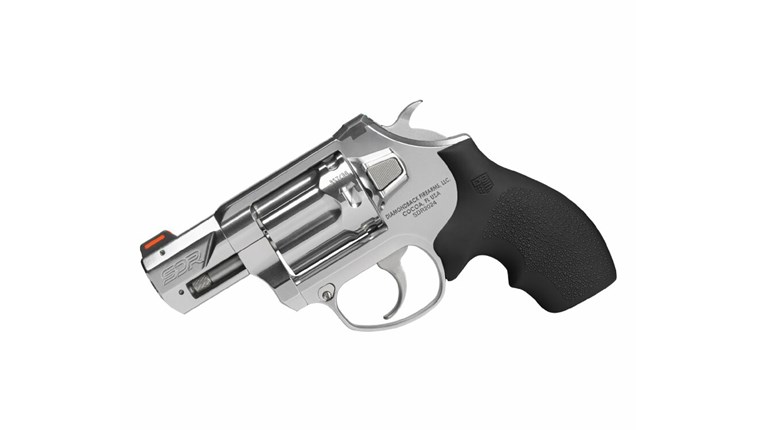
While the Colt 1911, Smith & Wesson revolver and even Glock G17 are iconic handguns whose very outlines are instantly recognizable, there’s another heavy-hitting pistol that’s becoming a Hollywood star in its own right. Whenever Hollywood is looking for the “pistol di tutti pistols,” it turns to the Desert Eagle, a gas-operated, big-bore monster.
Typically, though, it’s the .50 AE version shown, the “Desert Eagle, point-five-oh” so often bandied about in movies. I put a photo of the L5 up on Shooting Illustrated’s Facebook page, and a good number of the comments referenced the caliber: “A .357 Desert Eagle is like buying a four-cylinder Corvette.” “Wake me up when it’s .50 AE.” And, to a certain extent, there’s truth there—why not get the biggest and baddest if you’re going all-in for a Desert Eagle?
It would be tempting to put in something about recoil, here, but let’s be honest. If you’re willing to put up with a massive grip on a supremely heavy pistol, recoil really isn’t a concern. In fact, I’d wager it’s a selling point—much like bragging about owning a really powerful handgun like a Smith & Wesson .500 S&W Mag. Besides, the gas system really does take much of the sting out of even the .50 AE.

A quick look on ammoseek.com might yield some answers. The .357 Mag. has literally thousands of offerings, with the least-expensive options running right around a quarter a round. Run the same search for .50 AE and what do you find? Only 135 options (many are merely different packaging options), and the least-expensive fodder is $1.05 per round. If you’re planning on shooting your new Desert Eagle, it’s going to cost more to shoot the .50 AE over the .357 Mag.
Another thought, too, is this might appeal to fans of the .357 Mag. There’s one other semi-automatic handgun in .357 Mag. on the market, the Coonan (reviewed in January 2015). The L5 might hold appeal for the true .357 Mag. aficionado who wants something other than a revolver or lever-action rifle to shoot their favored caliber.
The L5 is marketed as the “Lightweight” variant, but at 50 ounces, that’s really a subjective measurement. Sure, when compared to the standard version, tipping the scales at more than 4 pounds, 50 ounces is a significant reduction. But, compared to a full-size, all-steel 1911 in .45 ACP that weighs .75-pound less (with the same barrel length), the L5 is highly unlikely to be anyone’s daily concealed-carry pistol. However, it is equally unlikely that anyone would be buying one specifically for that purpose.

It does, however, feed back into the “why .357 Mag. over .50 AE” argument with regard to weight and shootability. If you’re buying this because you really want to shoot it, you’ll appreciate the weight savings when you go to the range. The size and heft of the pistol, combined with its gas-operating system, take any possible sting of recoil out of the equation, and a weight savings of 20 ounces means more time shooting before fatigue sets in. Yes, I know, Desert Eagles are meant to be admired first, shot second. However, there are some of us out there who insist on shooting the guns we own. Being able to shoot more than a couple magazines before your arm tires is a plus. The unique porting also helps with recoil, but it makes a serious mess of your sandbag.
On the range, there were a few glitches and problems encountered. The L5 really does not like jacketed soft-point ammunition, requiring frequent assistance in feeding. I have not yet encountered a semi-automatic firearm that feeds JSP ammo reliably; while it’s possible they exist, I haven’t come across one. If you’re thinking about handgun-hunting with the L5, experiment with ammunition choices or be prepared to hand-cycle.
Full-metal-jacket and jacketed-hollowpoint ammunition worked much better, with only occasional failures to feed experienced throughout testing. Firing and extraction of all ammo was flawless—once the round makes it into the chamber, it goes boom and the empty case is heaved to Timbuktu. Some fouling in the later stages of testing was observed, and that almost certainly contributed to failures. Keep the L5 clean and run it with FMJ or JHP ammo for best results.
Accuracy seemed to be the L5’s strong suit. I’ve never been much of a long-range pistolero; a combination of poor eyesight and a desire to train at closer quarters means I don’t often shoot a handgun at 25 yards. The L5 gave some of the best results with iron sights of any pistol I’ve shot—coming in a close second to the SIG Sauer MPX in accuracy results—and the MPX was outfitted with a magnified optic (now, granted, it was a 1.5X ACOG). At closer distances, targets with a single ragged hole right on the “X” were not uncommon.
Is the L5 for everyone? Doubtful. Even though it’s a “lightweight” gun, it’s still pretty heavy and unwieldy. For the price, it’s tempting to go for the big 50 and be done, too. However, for the true .357 Mag. fan, it’s one of two semi-autos on the market today and offers less-expensive, less-fatiguing shooting than its bigger-bore brothers in the Desert Eagle line. If you want something truly unique that you’re likely to take to the range more than once or twice, the L5 just might fill that hole in your armory.





































